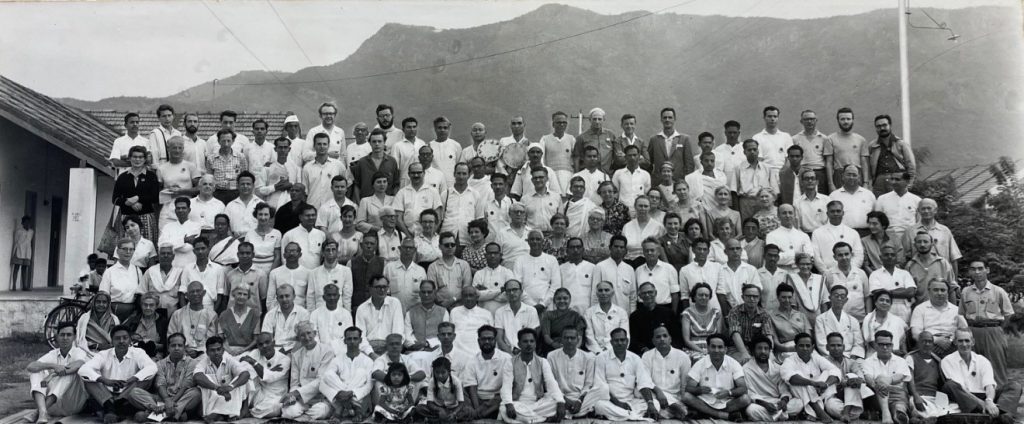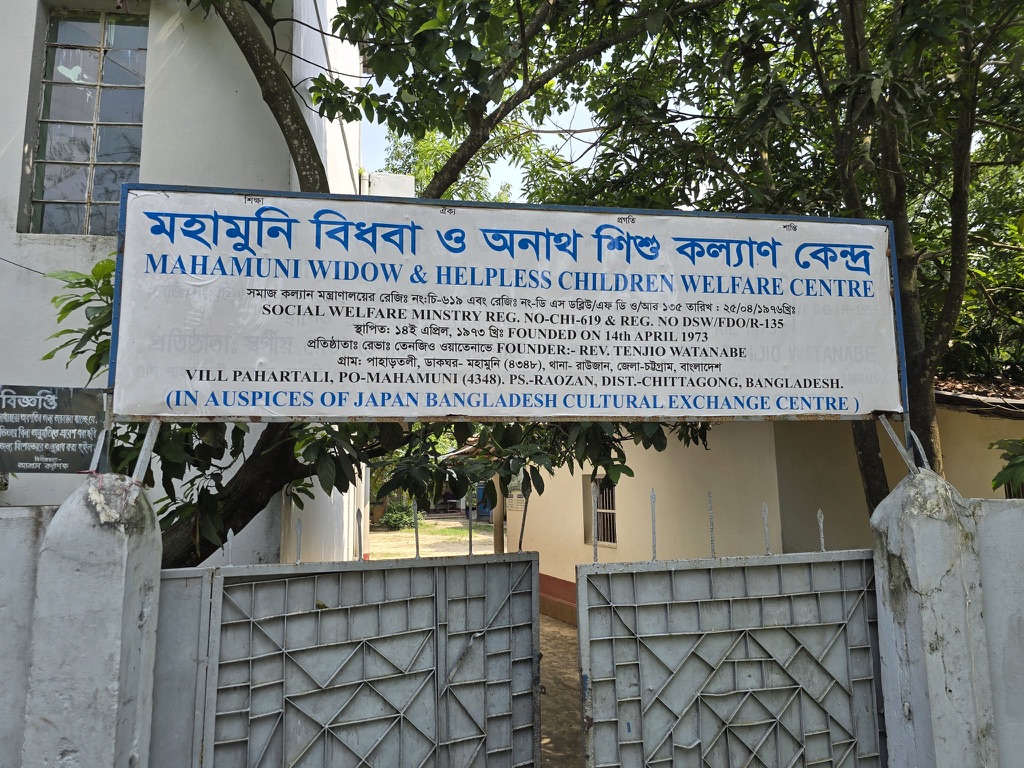
This group photo from the 1960 Tenth Triennial Congress of the War Resisters’ International at the Gandhigram Ashram in South India, was taken by a local Tamil photography studio, Samy Photo, just down the road from the ashram in Chinnalapatti. From the names printed in the framed version, it is clear that the studio aimed to identify every delegate on the photograph by name and position in the photo. To this end the photographer was working, most likely, with a Tamil volunteer from the ashram who worked in close proximity to the peace activists who had gathered there. Some of the names, especially non-Indian ones, are rendered phonetically. But it is not the “difficult names” that are spelled incorrectly – for instance, Gerhard Tschannerl’s name, though not the most intuitive one, is spelled perfectly. Tschannerl spend much time in India and married Gandhian activist Janaki Natarajan, with whom he participated in the Delhi-Peking Friendship March a few years later. The names of famous figures in the international pacifist movement, like Bayard Rustin, are equally correct. The few mistakes that do occur are in the names of delegates who – partly due to their own limited command of English – did not take center stage in the conference proceedings and would have appeared on the program and in the minutes a lot less than others. Cobi Molenaar is one such example: a school teacher from the Netherlands who was active in the ANVA (Algemene Nederlandse Vredesactie, a prominent Dutch pacifist organization), she appears to us as “Mohlanaar.” Similarly, “Yamaga” is Taiji Yamaga, president of the Japanese Anarchist Federation, who spoke to the conference in Esperanto rather than English. Finally, it lists a “Tanjo Watanabe”, of whom much less is known.
Most attendees pictured on the photo are easily cross-referenced from the conference, but the conference record unhelpfully lists him as “Rev. Watanabe”. Here, the conference liaison to Samy Photo Studio in Chinnalapatti actually did later researchers a favor: we have a given name, of sorts. Who was he?

“Tanjo” is in fact Tenjo Watanabe, a monk of the Nipponzan Myohoji, a small Nichiren Buddhist order established in 1917 by Nichidatsu Fujii. The Nipponzan Myohoji are committed to promoting peace and non-violence, and their relations to the Gandhian movement date back to 1933, when Nichidatsu Fujii visited Gandhi at his ashram in Wardha. Some of the members of the Nipponzan Myohoji who spent time in India and were active in the Gandhian movement have well-documented lives. Robert Kisala covers the sect and its founder in his Prophets of Peace, while Sato Gyotsu’s peace travels, especially the Hiroshima to Auschwitz March, have been well-covered by Ran Zwigenberg. Information on Tenjo Watanabe, however, is much more sparse. Within a year of his ordination, he left Japan for India. Despite being interned in Rajasthan in 1941 as a Japanese prisoner of war and not released until 1946.

Undeterred, he resumed his religious activities in India in 1955 and appears in our dataset as a delegate in Gandhigram in 1960. The best-recorded years of his life, however, start with the Bangladesh Liberation War. Moved by the living conditions of Bangladeshi widows and orphans, he spent years in Bangladesh as a representative of the Japanese Vedanta Society, an organization that had emerged near Osaka some years previous out of an Indian-Japanese study circle on the thought of Ramakrishna and Vivekananda. A few years later, he established the “Mahamuni Widow and Helpless Children Welfare Center” in order to set up a more durable relief organization in Bangladesh. Funded mostly by Buddhist donors in Japan, it soon became a fixture in Japanese-Bangladeshi relations as the “Bangladesh-Japan Cultural Exchange Center”. In the 1990s, Watanabe was credited for his work, first with the Sixth Order of Merit by the Emperor of Japan in 1994, and with the Mahatma Gandhi Peace Prize in 1996. Interestingly, this is one of the ways in which our dataset opens up new avenues of research – searching for biodata on Tenjo Watanabe also yielded information a fellow Japanese Buddhist monk who joined him at the Mahamuni Welfare Center, and ended up establishing a Theravada Buddhist monastery on the other side of Bangladesh, in Rangpur.
One response to “Tenjo Watanabe”
It’s fascinating to learn about the local Tamil photography studio, Samy Photo, documenting this important Congress. I found some interesting historical context on similar gatherings at https://tinyfun.io/game/shadow-strike that helped me understand the significance of the event even more.